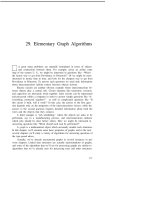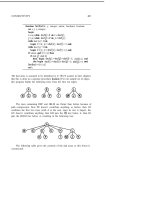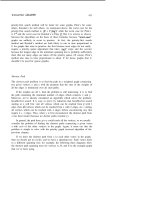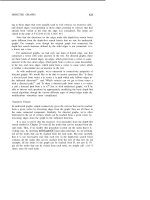Thuật toán Algorithms (Phần 37)
Bạn đang xem bản rút gọn của tài liệu. Xem và tải ngay bản đầy đủ của tài liệu tại đây (76.64 KB, 10 trang )
GEOMETRIC INTERSECTION
353
by A is performed on the rightmost tree in the diagram above. This search
discovers the intersections between A and E, F, and I. (Recall that although
G and J are visited during this search, any points to the left of G or to the
right of J would not be touched.) Finally, the upper endpoints of G, J, F, E,
and I are encountered, so those points are successively deleted, leading back
to the empty tree.
The first step in the implementation is to sort the line endpoints on their
y coordinate. But since binary trees are going to be used to maintain the
status of vertical lines with respect to the horizontal scan line, they may as
well be used for the initial y sort! Specifically, we will use two “indirect”
binary trees on the line set, one with header node hy and one with header
node hx. The y tree will contain all the line endpoints, to be processed in
order one at a time; the x tree will contain the lines that intersect the current
horizontal scan line. We begin by initializing both hx and hy with 0 keys
and pointers to a dummy external node z, as in treeinitialize in Chapter 14.
Then the hy tree is constructed by inserting both y coordinates from vertical
lines and the y coordinate of horizontal lines into the binary search tree with
header node hy, as follows:
procedure
var N, k, xl, x2, integer;
begin
readln (N)
for to N do
begin
readln (xl, , x2,
hy);
if then (k, hy) ;
end
end
This program reads in groups of four numbers which specify lines, and puts
them into the lines array and the binary search tree on the y coordinate. The
standard routine from Chapter 14 is used, with the y coordinates as
keys, and indices into the array of lines as the info field. For our example set
of lines, the following tree is constructed:
354 CHAPTER 27
Now, the sort on is effected by a recursive program with the same recursive
structure as the treeprint routine for binary search trees in Chapter 14. We
visit the nodes in increasing y order by visiting all the nodes in the left
of the hy tree, then visiting the root, then visiting all the nodes in the right
of the hy tree. At the same time, we maintain a separate tree (rooted
at hx) as described above, to simulate the operation of passing a horizontal
scan line through. The code at the point where each node is “visited” is rather
straightforward from the description above. First, the coordinates of the
endpoint of the corresponding line are fetched from the lines array, indexed
by the info field of the node. Then the key field in the node is compared
against these to determine whether this node corresponds to the upper or the
lower endpoint of the line: if it is the lower endpoint, it is inserted into the
hx tree, and if it is the upper endpoint, it is deleted from the hx tree and
a range search is performed. The implementation differs slightly from this
description in that horizontal lines are actually inserted into the hx tree, then
immediately deleted, and a range search for a one-point interval is performed
for vertical lines. This makes the code properly handle the case of overlapping
vertical lines, which are considered to “intersect.”
GEOMETRIC INTERSECTION
procedure scan (next: link) ;
var xl, x2, integer;
int: interval;
begin
if next< then
begin
if then begin xl end;
if then begin end;
if then xl, hx);
if nextf then
begin
xl, hx);
int);
wri ;
end
scan
end
end
The running time of this program depends on the number of intersections that
are found as well as the number of lines. The tree manipulation operations
take time proportional to on the average (if balanced trees were used,
a worst case could be guaranteed), but the time spent in also
depends on the total number of intersections it returns, so the total running
time is proportional to N log where is the number of intersecting pairs.
In general, the number of intersections could be quite large. For example, if
we have N/2 horizontal lines and N/2 vertical lines arranged in a crosshatch
pattern, then the number of intersections is proportional to As with
range searching, if it is known in advance that the number of intersections
will be very large, then some brute-force approach should be used. Typical
applications involve a “needle-in-haystack” sort of situation where a large set
of lines is to be checked for a few possible intersections.
This approach of intermixed application of recursive procedures operat-
ing on the x and y coordinates is quite important in geometric algorithms.
Another example of this is the 2D tree algorithm of the previous chapter, and
we’ll see yet another example in the next chapter.
356
CHAPTER 27
General Line Intersection
When lines of arbitrary slope are allowed, the situation can become more
complicated, as illustrated by the following example.
First, the various line orientations possible make it necessary to test explicitly
whether certain pairs of lines intersect: we can’t get by with a simple interval
range test. Second, the ordering relationship between lines for the binary
tree is more complicated than before, as it depends on the current y range
of interest. Third, any intersections which do occur add new “interesting” y
values which are likely to be different from the set of y values that we get
from the line endpoints.
It turns out that these problems can be handled in an algorithm with the
same basic structure as given above. To simplify the discussion, we’ll consider
an algorithm for detecting whether or not there exists an intersecting pair in
a set of lines, and then we’ll discuss how it can be extended to return all
intersections.
As before, we first sort on y to divide the space into strips within which
no line endpoints appear. Just as before, we proceed through the sorted list
of points, adding each line to a binary search tree when its bottom point is
encountered and deleting it when its top point is encountered. Just as before,
the binary tree gives the order in which the lines appear in the horizontal
GEOMETRIC INTERSECTION
357
“strip” between two consecutive y values. For example, in the strip between
the bottom endpoint of D and the top endpoint of B in the diagram above,
the lines should appear in the order F B D G H. We assume that there are
no intersections within the current horizontal strip of interest: our goal is to
maintain this tree structure and use it to help find the first intersection.
To build the tree, we can’t simply use coordinates from line endpoints
as keys (doing this would put B and D in the wrong order in the example
above, for instance). Instead, we use a more general ordering relationship: a
line x is defined to be to the right of a line y if both endpoints of x are on the
same side of y as a point infinitely far to the right, or if y is to the left of
with “left” defined analagously. Thus, in the diagram above, B is to the right
of A and B is to the right of C (since C is to the left of B). If x is neither
to the left nor to the right of y, then they must intersect. This generalized
“line comparison” operation is a simple extension of the same procedure of
Chapter 24. Except for the use of this function whenever a comparison is
needed, the standard binary search tree procedures (even balanced trees, if
desired) can be used. For example, the following sequence of diagrams shows
the manipulation of the tree for our example between the time that line C is
encountered and the time that line D is encountered.
B
H
G
B
F
H
G
D
Each “comparison” performed during the tree manipulation procedures is
actually a line intersection test: if the binary search tree procedure can’t
decide to go right or left, then the two lines in question must intersect, and
we’re finished.
But this is not the whole story, because this generalized comparison
operation is not transitive. In the example above, F is to the left of B (because
B is to the right of F) and B is to the left of D, but F is not to the left of D. It
is essential to note this, because the binary tree deletion procedure assumes
that the comparison operation is transitive: when B is deleted from the last
tree in the above sequence, the tree









